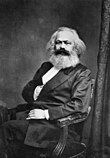
Back ميل معدل الربح إلى الانخفاض Arabic Mənfəət dərəcəsinin aşağı düşməsi tendensiyası Azerbaijani Gesetz des tendenziellen Falls der Profitrate German Tendenca falo de la profitkvoto Esperanto Tendencia decreciente de la tasa de ganancia Spanish Baisse tendancielle du taux de profit French Kecenderungan laba untuk menurun ID Caduta tendenziale del saggio di profitto Italian 利潤率の傾向的低下の法則 Japanese 이윤율의 경향적 저하 법칙 Korean
| Part of a series on the |
| Marxian critique of political economy |
|---|
 |
The tendency of the rate of profit to fall (TRPF) is a theory in the crisis theory of political economy, according to which the rate of profit—the ratio of the profit to the amount of invested capital—decreases over time. This hypothesis gained additional prominence from its discussion by Karl Marx in Chapter 13 of Capital, Volume III,[1] but economists as diverse as Adam Smith,[2] John Stuart Mill,[3] David Ricardo[4] and William Stanley Jevons[5] referred explicitly to the TRPF as an empirical phenomenon that demanded further theoretical explanation, although they differed on the reasons why the TRPF should necessarily occur.[6]
Geoffrey Hodgson stated that the theory of the TRPF "has been regarded, by most Marxists, as the backbone of revolutionary Marxism. According to this view, its refutation or removal would lead to reformism in theory and practice".[7] Stephen Cullenberg stated that the TRPF "remains one of the most important and highly debated issues of all of economics" because it raises "the fundamental question of whether, as capitalism grows, this very process of growth will undermine its conditions of existence and thereby engender periodic or secular crises."[8]
- ^ It is also referred to by Marx as the "law of the tendency of the rate of profit to fall" (LTRPF). As explained in the article, there are disputes about whether there is such a law or not. Other terms used include "the falling rate of profit" (FROP), the "falling tendency of the rate of profit" (FTRP), "decline of the rate of profit" (DROP), and the "tendential fall of the rate of profit" (TFRP). The average rate of profit on production capital is usually written as r = S/(C+V).
- ^ Adam Smith, The Wealth of Nations, Chapter 9. See also Philip Mirowski, "Adam Smith, Empiricism, and the Rate of Profit in Eighteenth-Century England." History of Political Economy, Vol. 14, No. 2, Summer 1982, pp. 178–198.
- ^ John Stuart Mill, Principles of Political Economy (1848), Book 4, Chapter 4. Bela A. Balassa, "Karl Marx and John Stuart Mill." Weltwirtschaftliches Archiv, Bd. 83 (1959), pp. 147–165.
- ^ David Ricardo, Principles of Political Economy and Taxation, Chapter 6. Maurice Dobb, "The Sraffa system and critique of the neoclassical theory of distribution." In : E.K. Hunt & Jesse G. Schwartz, A Critique of Economic Theory. Penguin, 1972, p. 211–213.
- ^ W. Stanley Jevons (1871), The Theory of Political Economy. Harmondsworth, Penguin Books, 1970, pp. 243–244.
- ^ Aspromourgos, Tony, "Profits", in: James D. Wright (ed.), International Encyclopedia of the Social & Behavioural Sciences. Amsterdam: Elsevier, 2015, 2nd edition, Vol. 19, pp. 111–116.
- ^ Geoffrey M. Hodgson, After Marx and Sraffa. Essays in political economy. New York: St Martin's Press, 1991, p.28.
- ^ Stephen Cullenberg, The Falling Rate of Profit: Recasting the Marxian Debate. London: Pluto Press, 1994, p.1.
© MMXXIII Rich X Search. We shall prevail. All rights reserved. Rich X Search